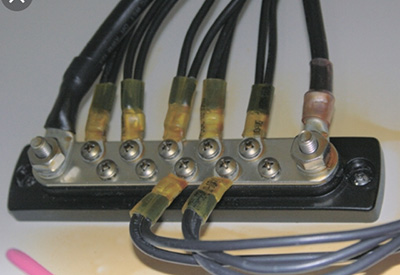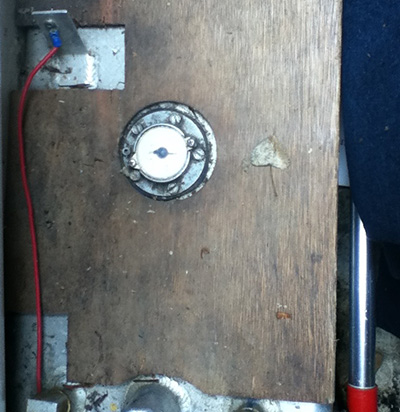Ask Andrew: Electrical Installations – Part 3: Grounding and Bonding

Feb 14, 2019
Grounding is always an interesting idea when on a boat. Can a boat be ‘grounded’ when it’s in the water?
Electrical ground is a term used to describe the reference point in an electrical circuit from which voltage is measured, a common return path for electric current, or a direct physical connection to the earth.
Connection to ground is also important in order to trigger protective mechanisms in the event of failure of internal insulation, and also limits the build-up of static electricity.
‘Ground’ is misleading – in that the term in also used in cell phones, cars and boats – none of which are connected to the earth. A different but suitable term is ‘common’. A ‘common’ connection is usually a large conductor (wire) attached to one side of the power supply. The black (negative) conductor running from the boat’s battery to the engine block, could be called ‘common’ rather than ‘ground’.
So why is a ‘ground’ important on a boat? A simple wiring diagram showing the battery, engine block ground, and ground bus-bar
A simple wiring diagram showing the battery, engine block ground, and ground bus-bar
If an electronic device develops a short-circuit from the power supply side to the equipment’s metal case, the case would then be ‘hot’ and would be a potentially dangerous source of electrical shock or ignition. By ‘grounding’ each appliance (whether AC or DC), you are providing an immediate and easy path for the electricity to travel, eliminating the danger of shock and ignition (and reducing the possibility of corrosion). On a boat, this path to ‘ground’ is generally to the engine block. A typical set-up on a boat includes a heavy gauge cable running from each negative battery post to the engine block grounding post. Each electrical appliance is also grounded to a main bus bar, and the bus bar is grounded, using a cable running to the engine block grounding post, as well.
A few important notes about this set-up:
1) Each cable used should be checked against an ampacity chart (discussed in part 1 of this series) to ensure that the cable size is correct, given the amount of current being carried, and the length of cable run
2) Each cable should be secure and torqued to specifications, using appropriate connections (discussed in part 2 of this series)
3) Grounds should be checked periodically, using a multimeter. This will ensure that short circuits, corrosion, and loose connections haven’t crept in, reducing the effectiveness of the grounding efforts.
 Note the forward keel boat, with a bonding wire running between it and a common bonding bus bar
Note the forward keel boat, with a bonding wire running between it and a common bonding bus bar
‘Bonding’ is a similar but distinct term. Bonding is the practice of electrically tying together all the large metal objects on a boat. This serves multiple purposes: prevents corrosion damage, provides lightening protection, and serves to reduce static electricity build up and provides ignition protection. The items commonly tied together include: fuel tanks, metal casings (water heaters, as an example), keel bolts, propellers/shafts, engine, transmission, stern-drive, and mast steps. The key to a good bonding system is the use of short-runs, with high-conductivity wiring: tinned-copper wiring, of at least #8 AWG (6 AWG if lighting protection is desired) is the rule of thumb suggested. Many bonding systems employ multiple bus bars or a common grounding conductor in order to keep these wire runs as short as possible. The bonding cables used to connect electrical equipment (AC and DC panels, as an example) should be larger than the current-carrying wiring in the circuits (so that if there is a short to the equipment casing, the bonding cable may carry current – and the cabling should be large enough that it wont melt and start a fire).
A typical set-up involves each component to be bonded, bonded separately. This means that components aren’t wired together in series; rather, each component should be bonded individually to a common ground bus, and that ground bus ground to the battery negative post.
 A fuel tank showing a bonding wire (8AWG) running between the fuel tank and a common bonding bus bar>
A fuel tank showing a bonding wire (8AWG) running between the fuel tank and a common bonding bus bar>
A good bonding system will have multiple sized conductors to account for each application. Each component will be bonded individually, and any bonding conductors should be rated to carry current, even though carrying current is not the purpose of bonding.
It’s particularly important to review both grounding and bonding on a boat that has had any equipment changes, electrical upgrades or installations, or significant changes to wiring. Older boats often have incomplete or partial grounding/bonding, and therefore don’t function to protect the boat. Winter layup is a great time to review your systems to make sure that they are installed correctly and are functioning as designed.
 Andrew McDonald is the owner of Lakeside Marine Services – a boat repair/maintenance firm based in Toronto. Andrew has worked in the marine industry for 12 years and is a graduate of the Georgian College ‘Mechanical Techniques – Marine Engine Mechanic’ program.
Andrew McDonald is the owner of Lakeside Marine Services – a boat repair/maintenance firm based in Toronto. Andrew has worked in the marine industry for 12 years and is a graduate of the Georgian College ‘Mechanical Techniques – Marine Engine Mechanic’ program.
Questions or comments for Andrew? Email him directly via: askandrew@lakesidemarineservices.ca




























